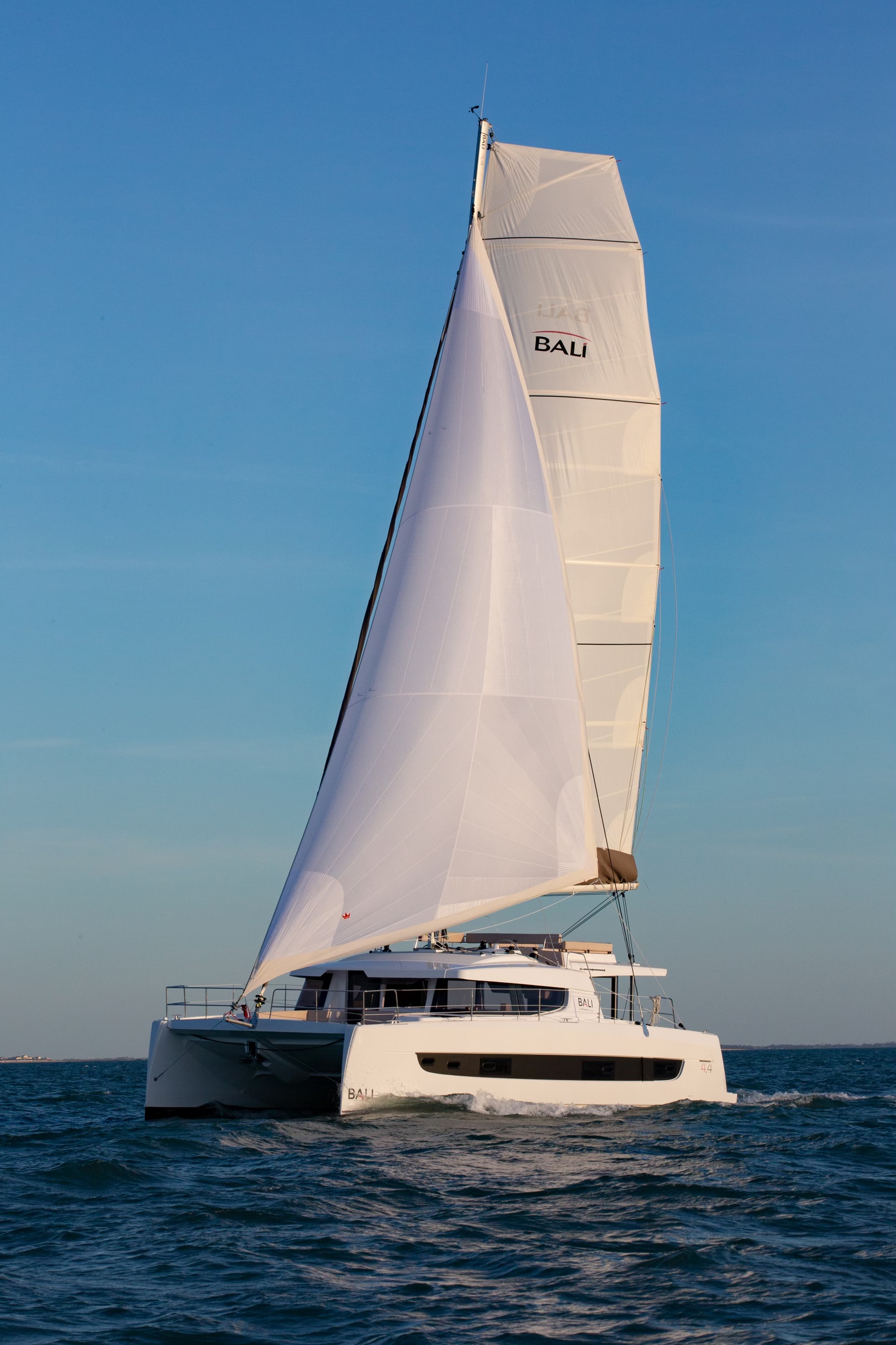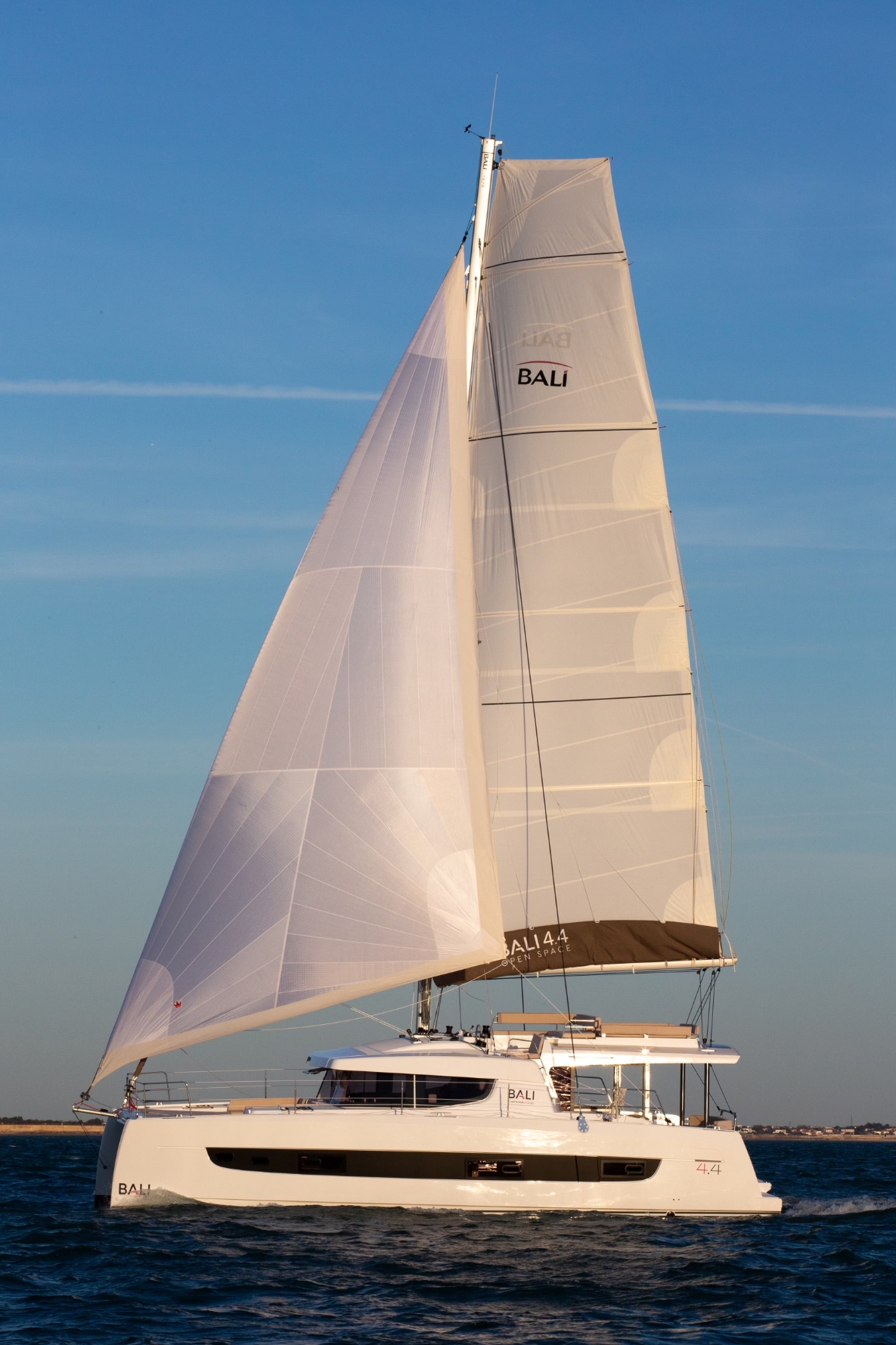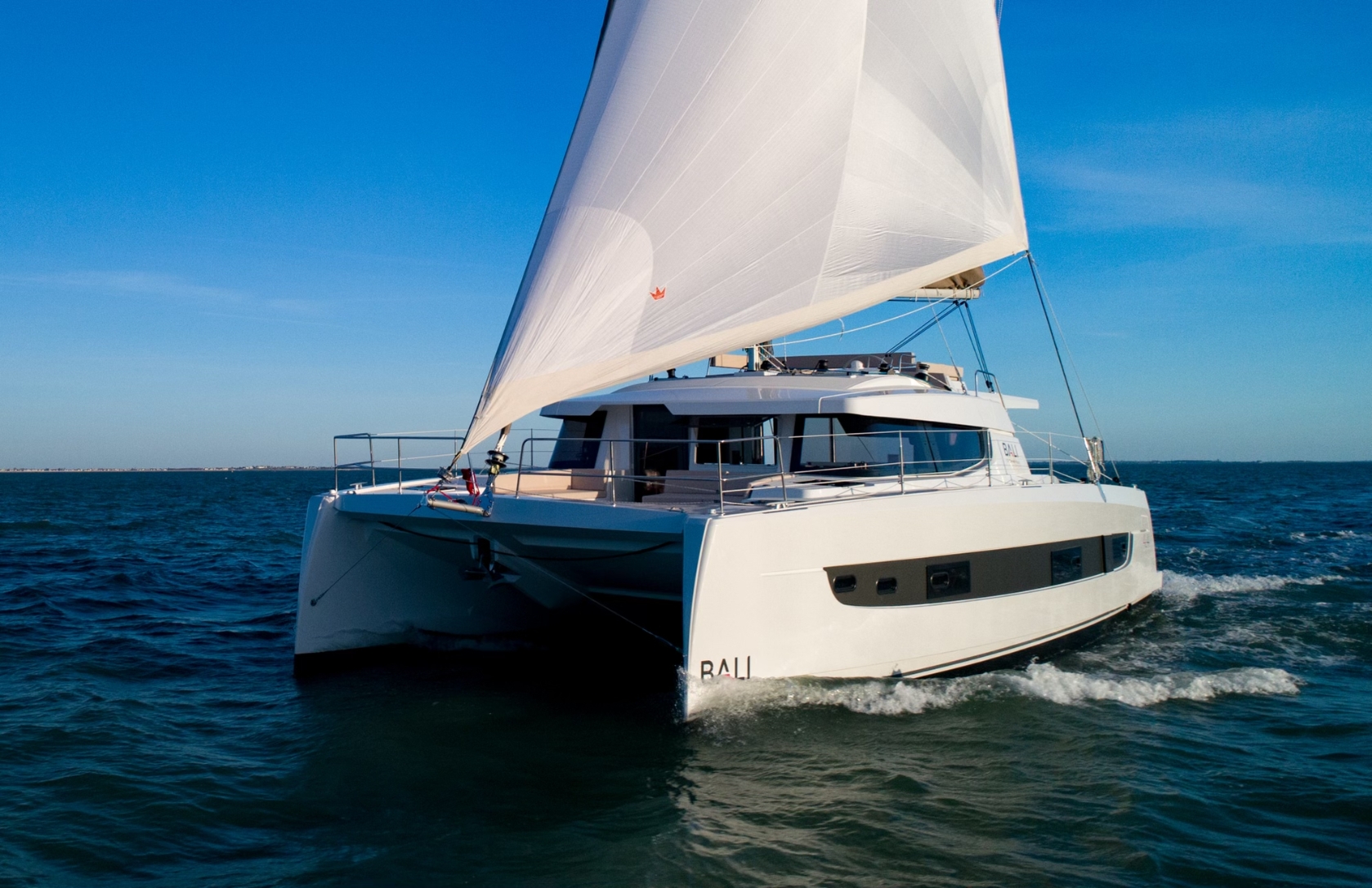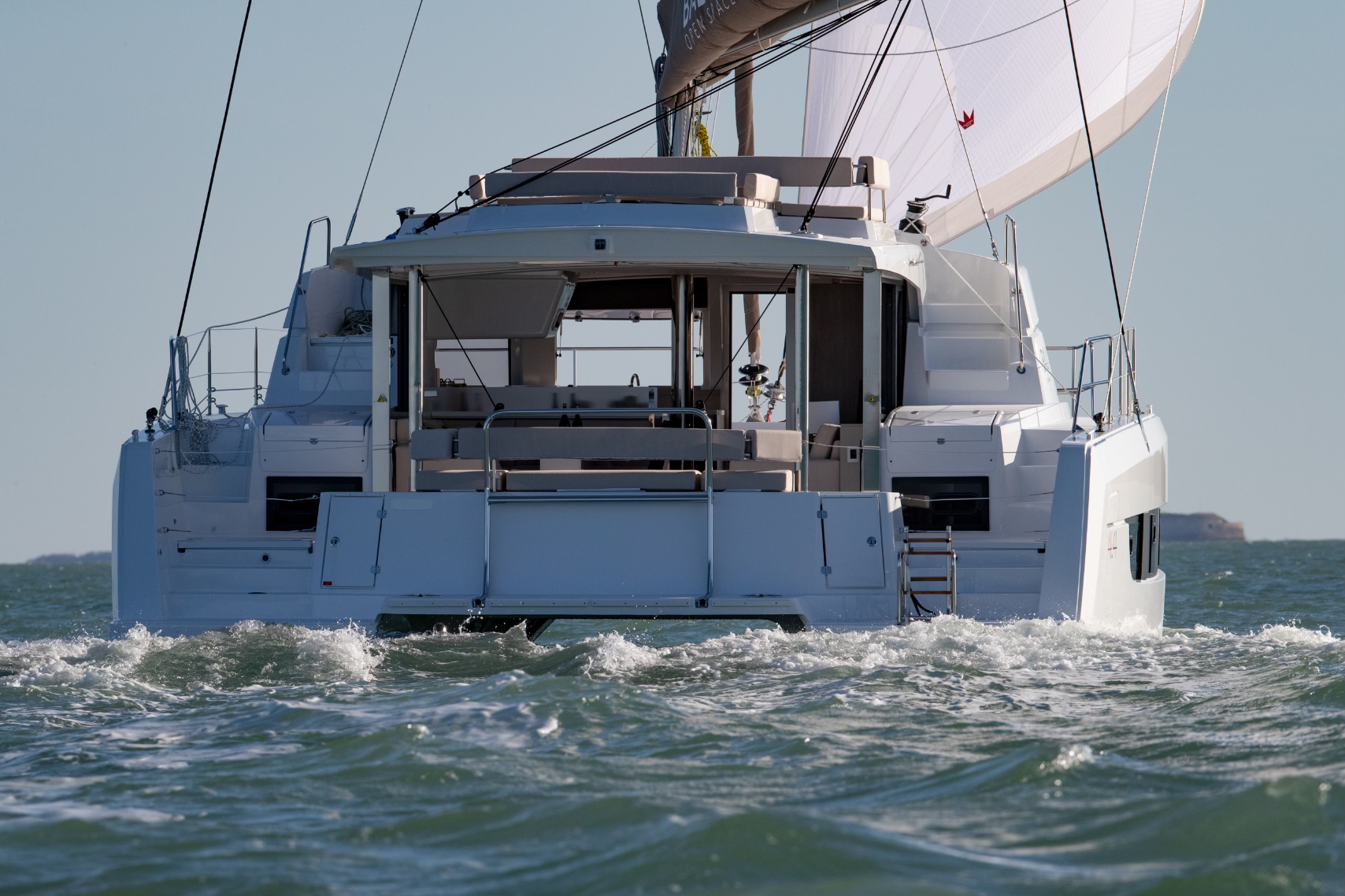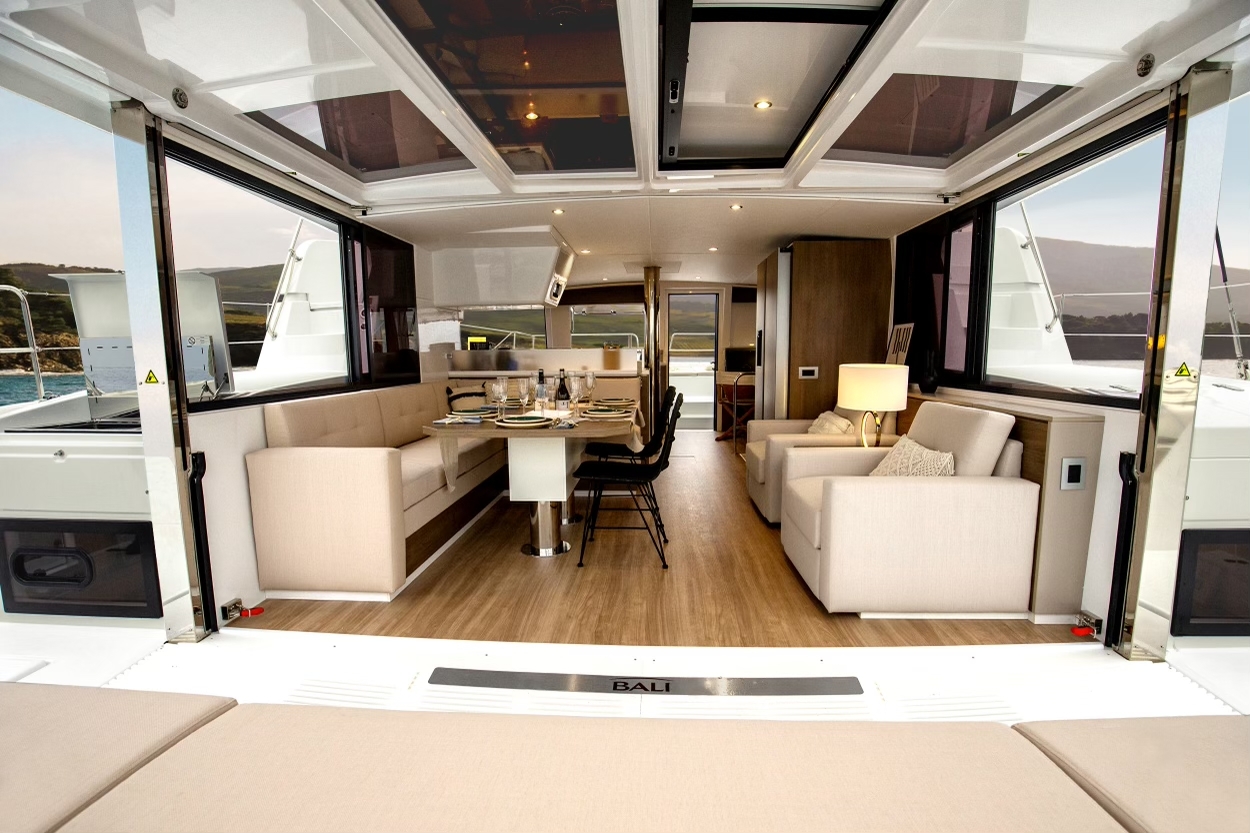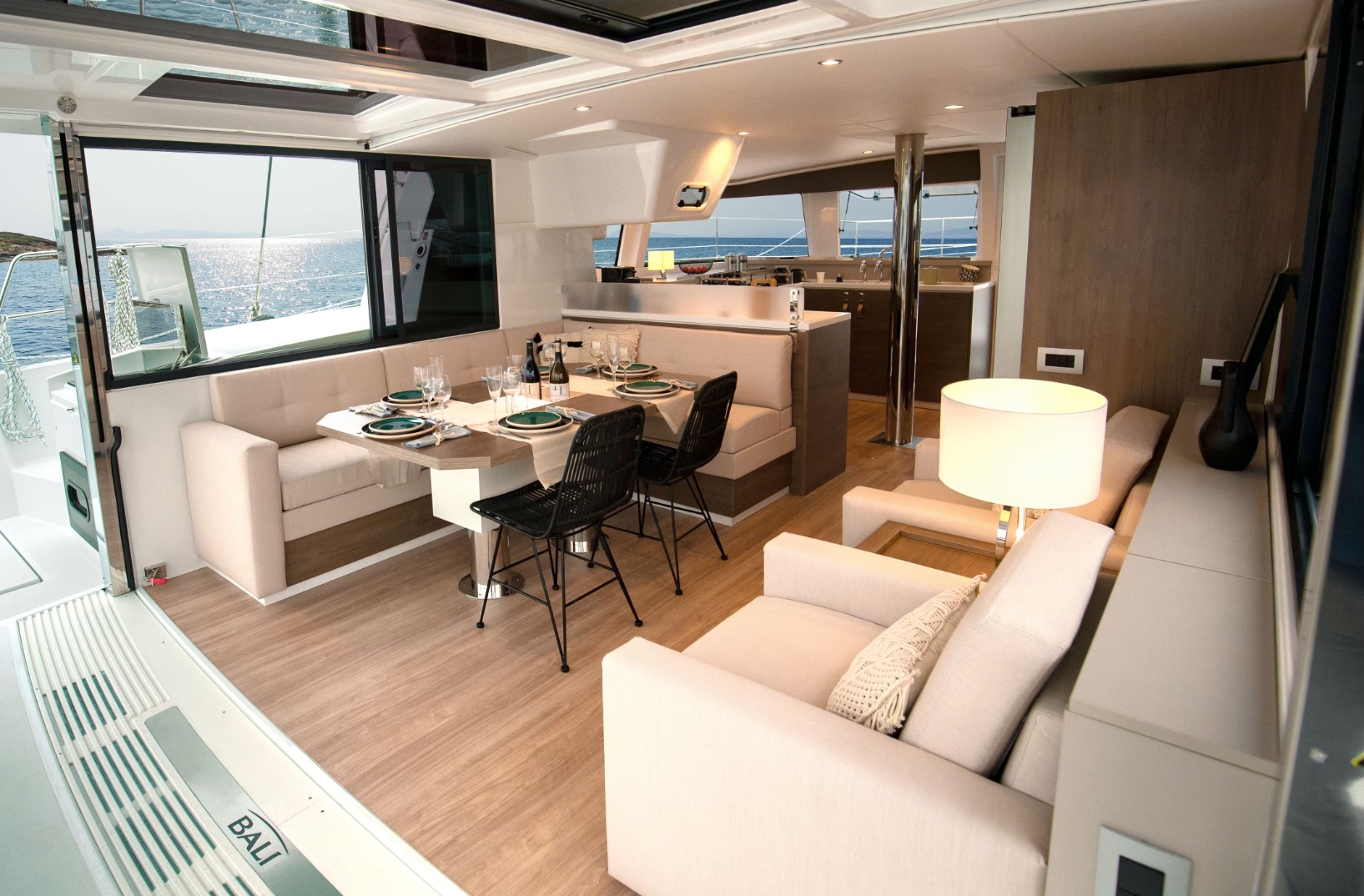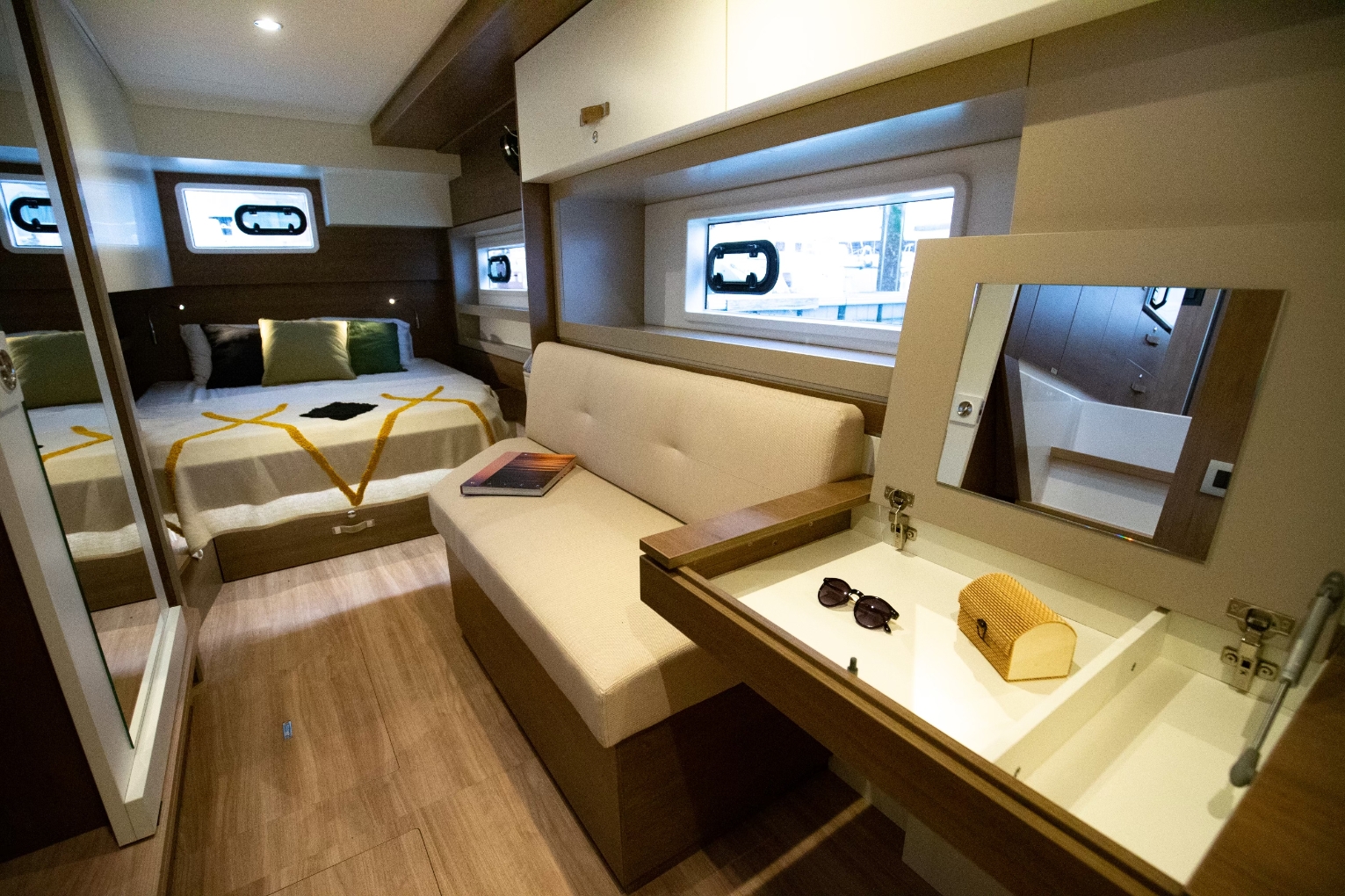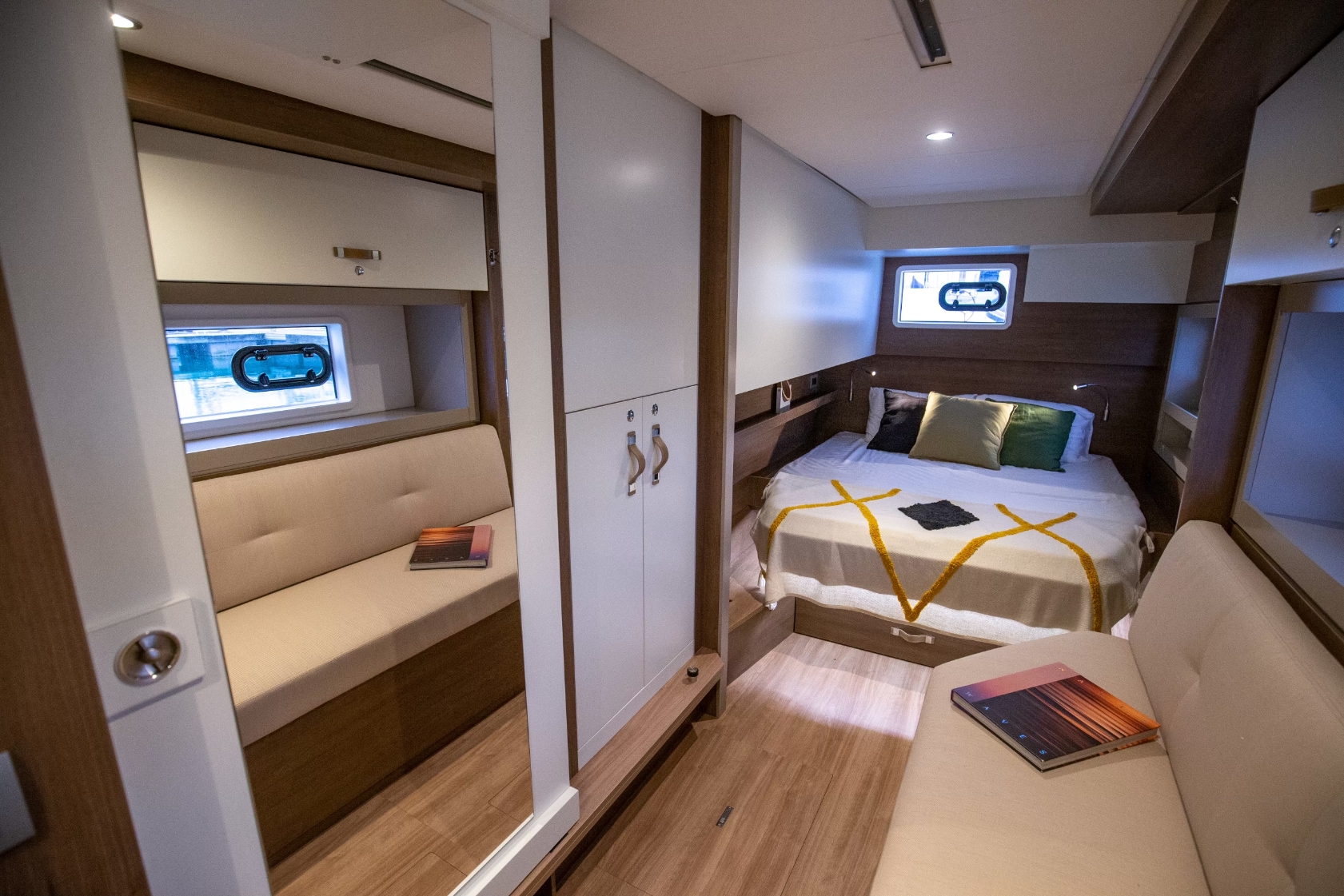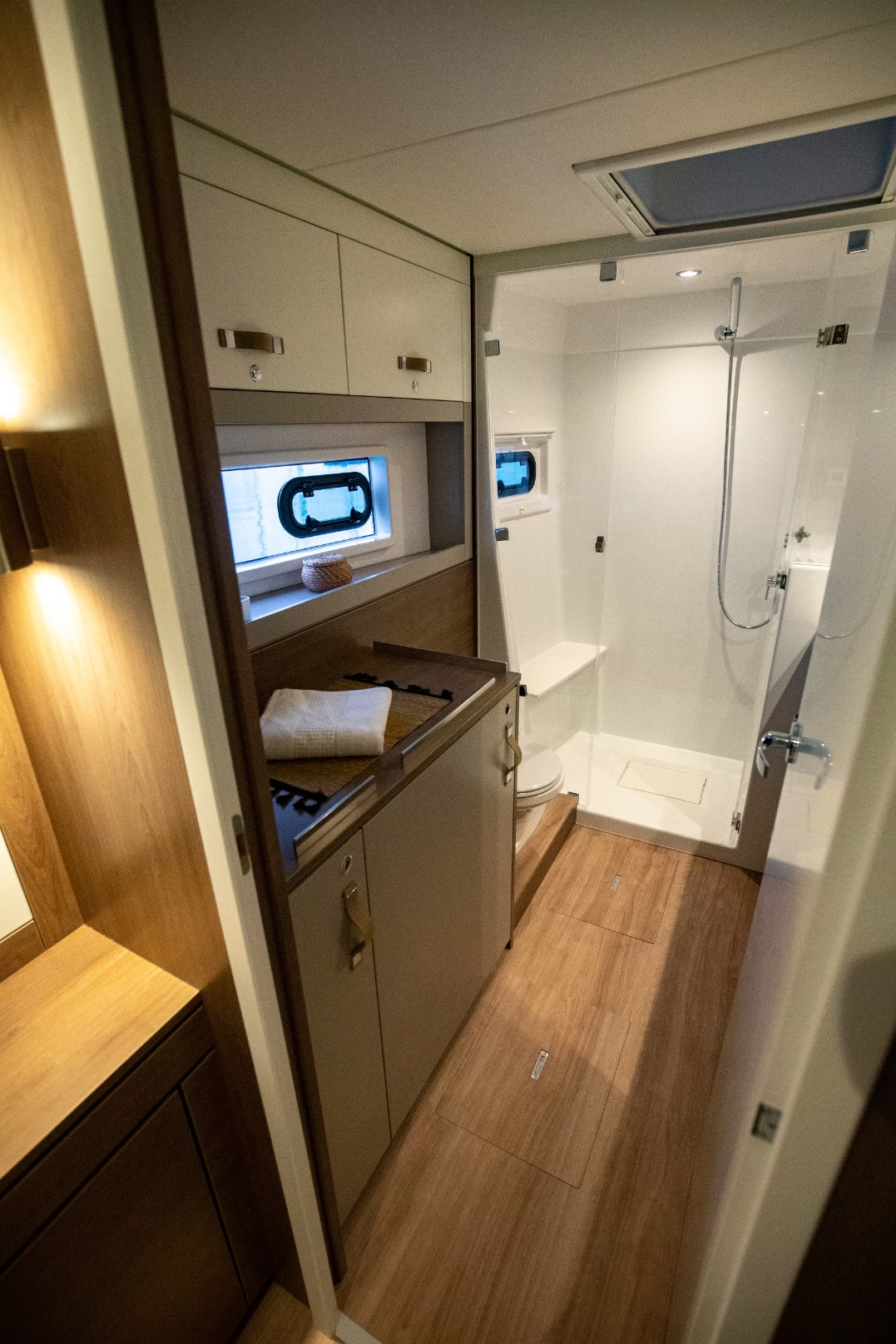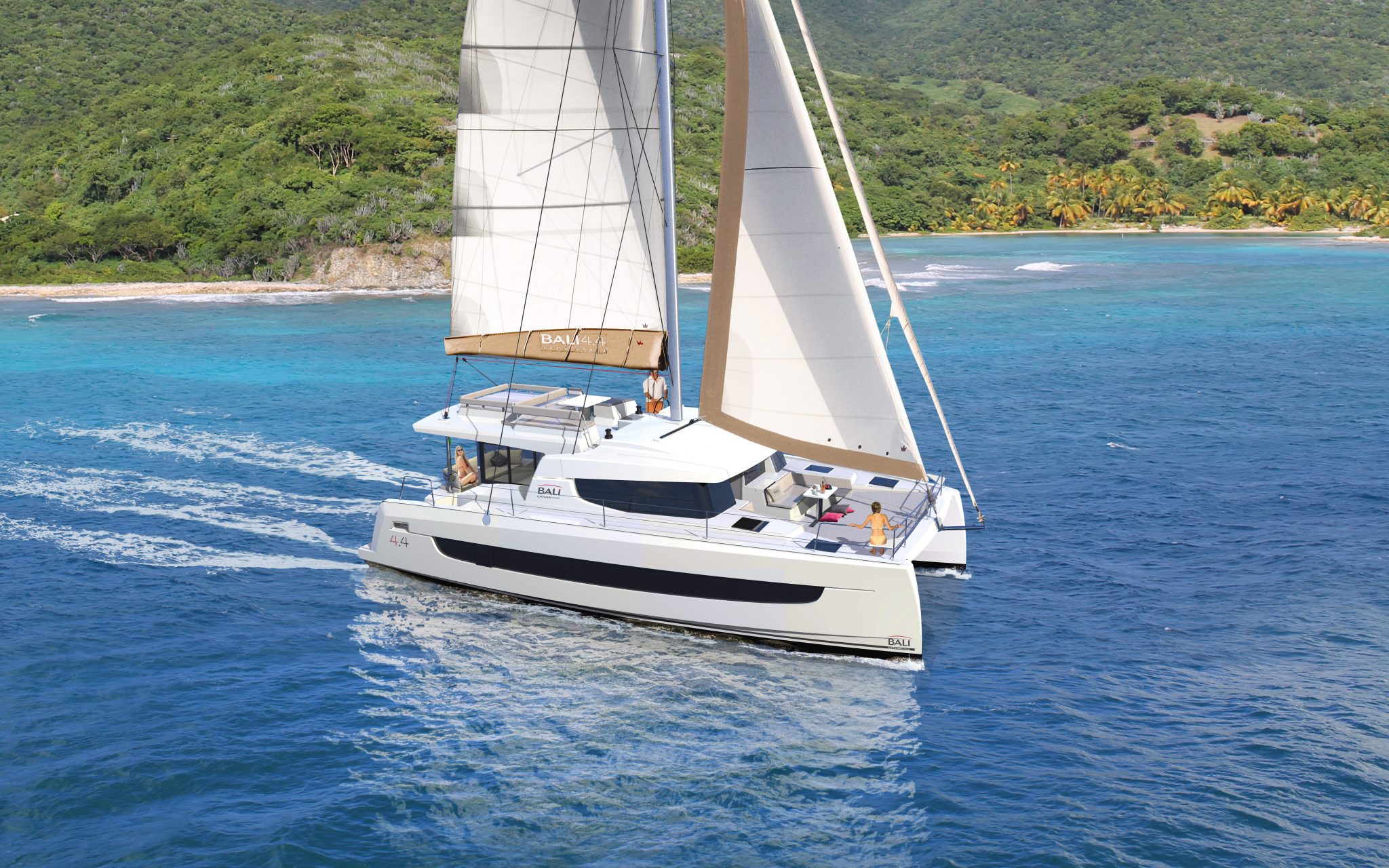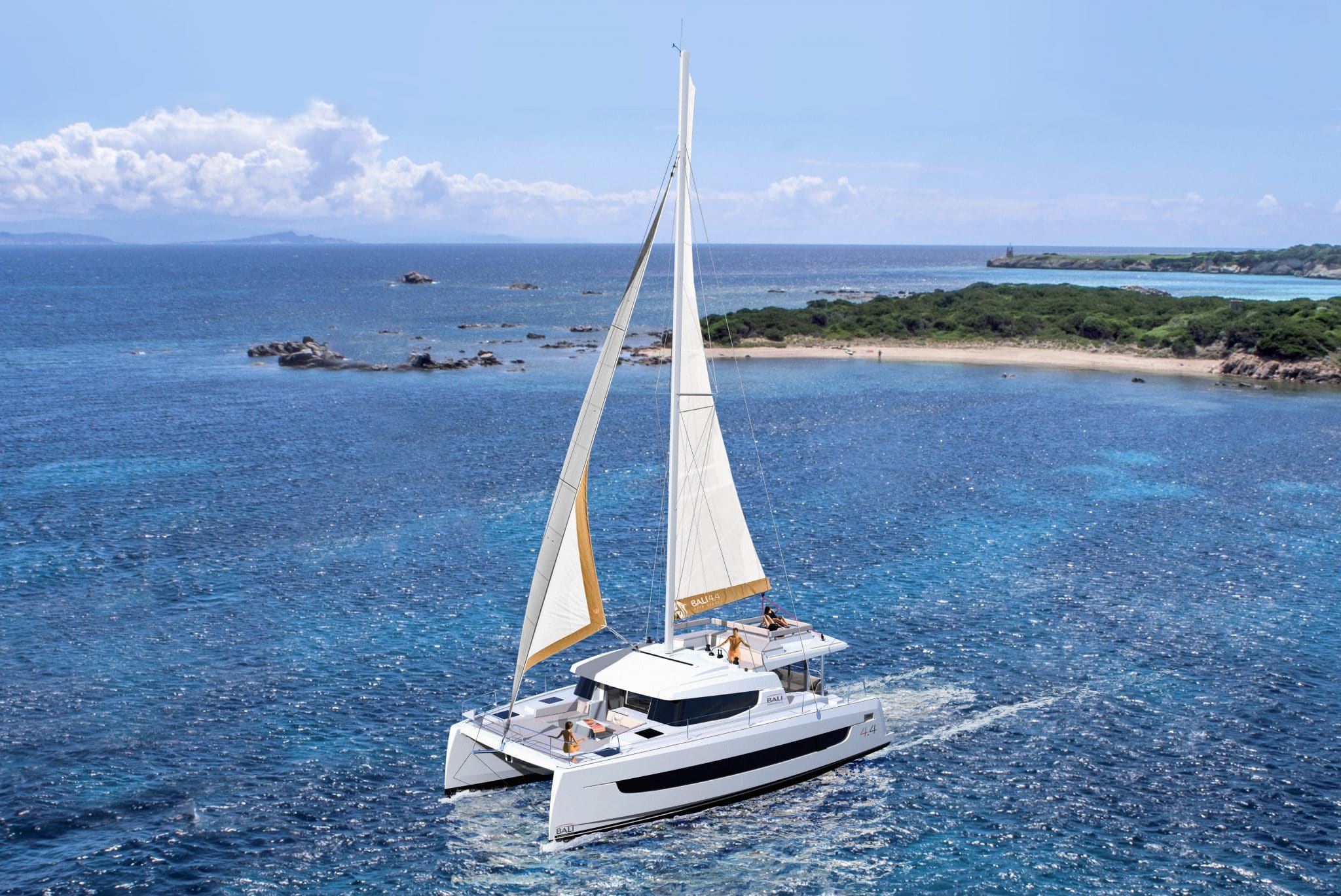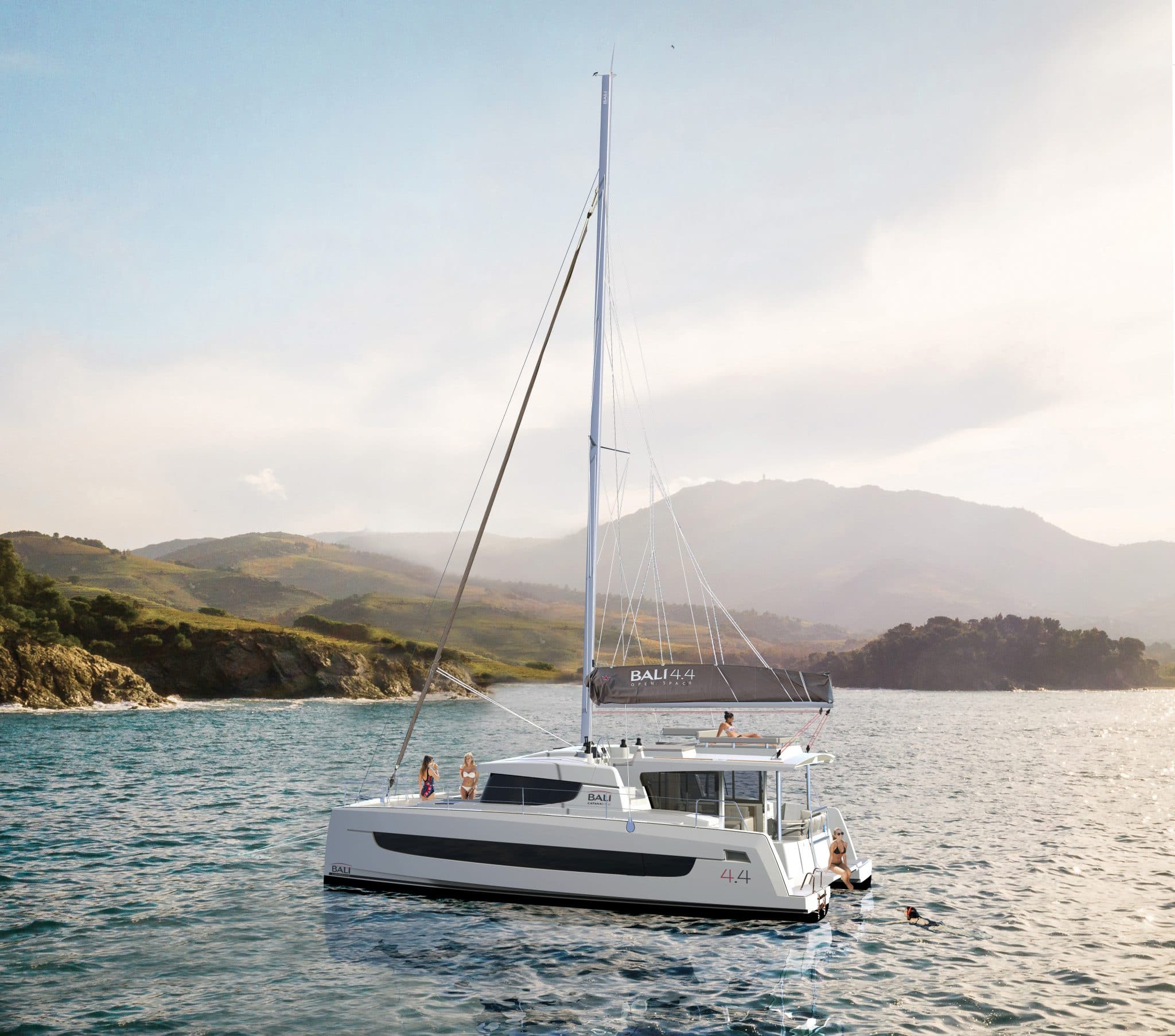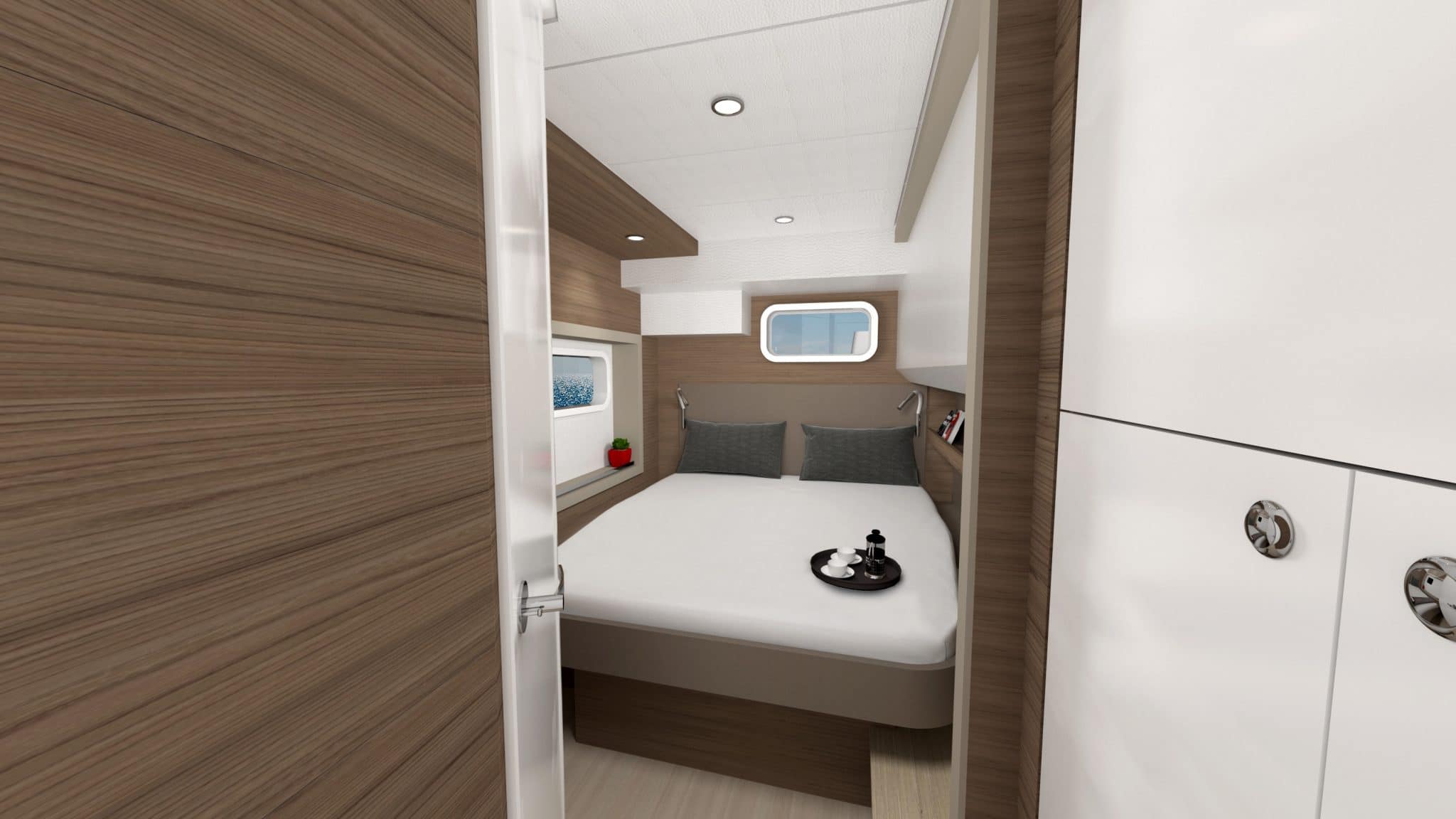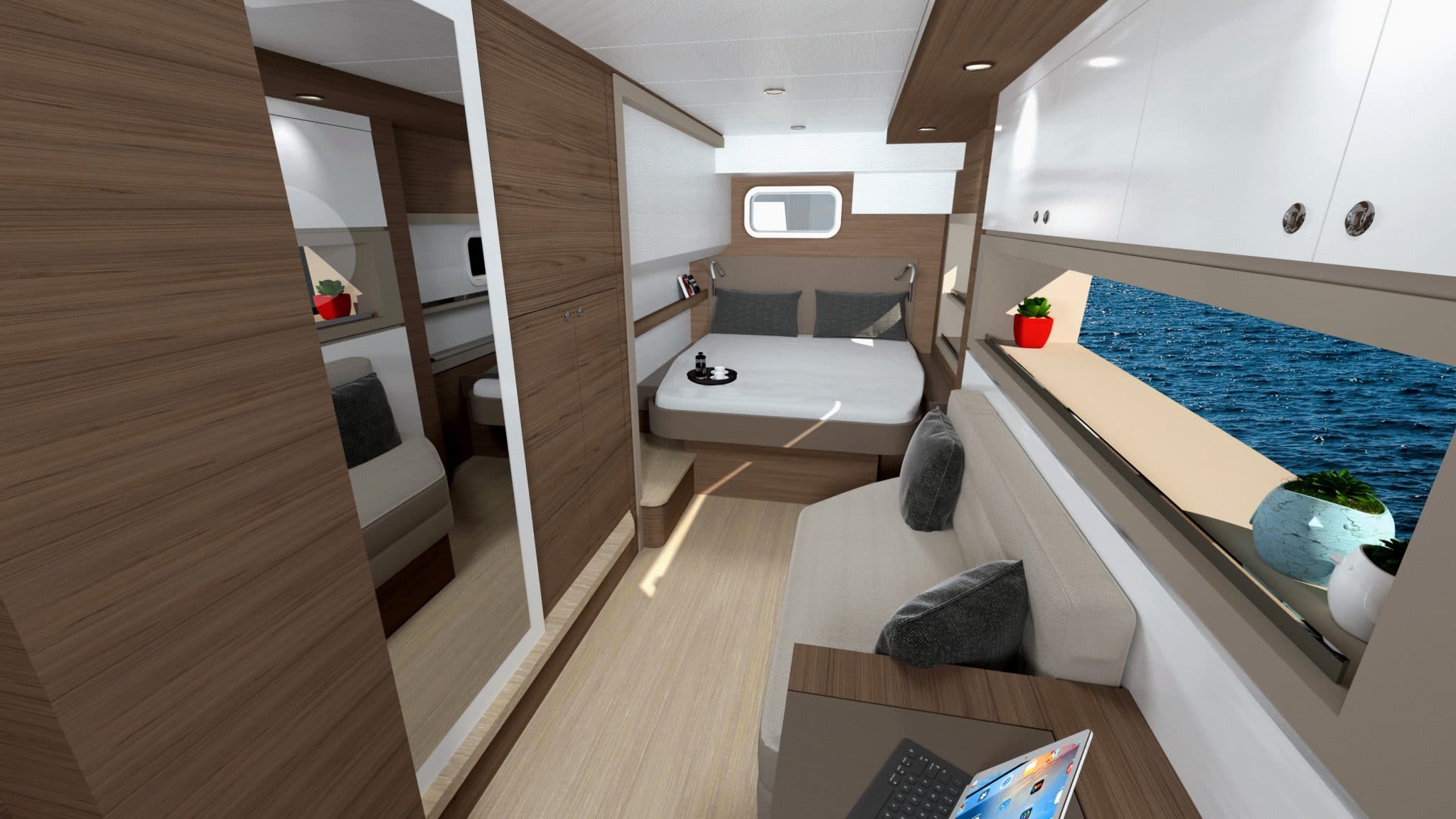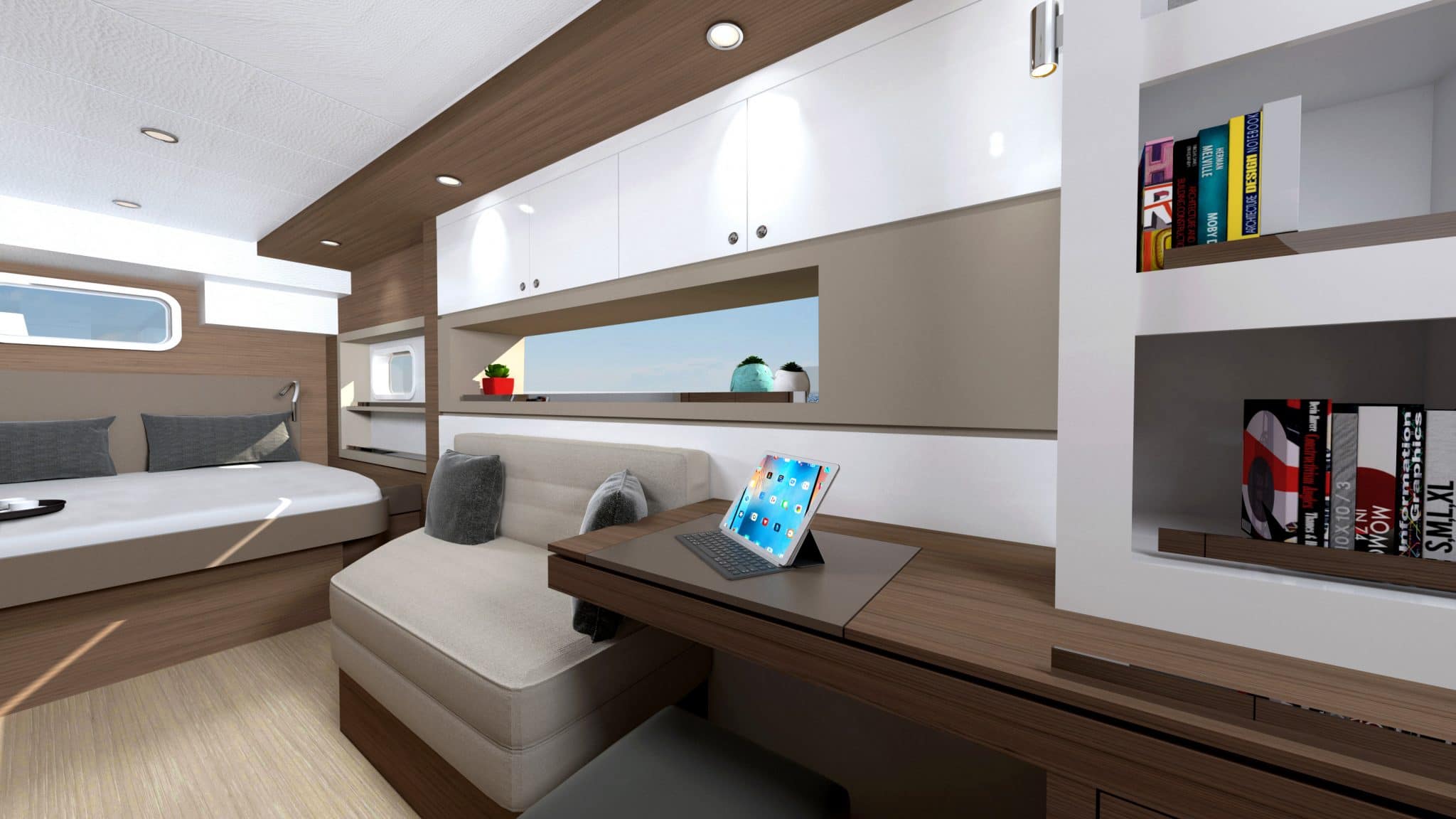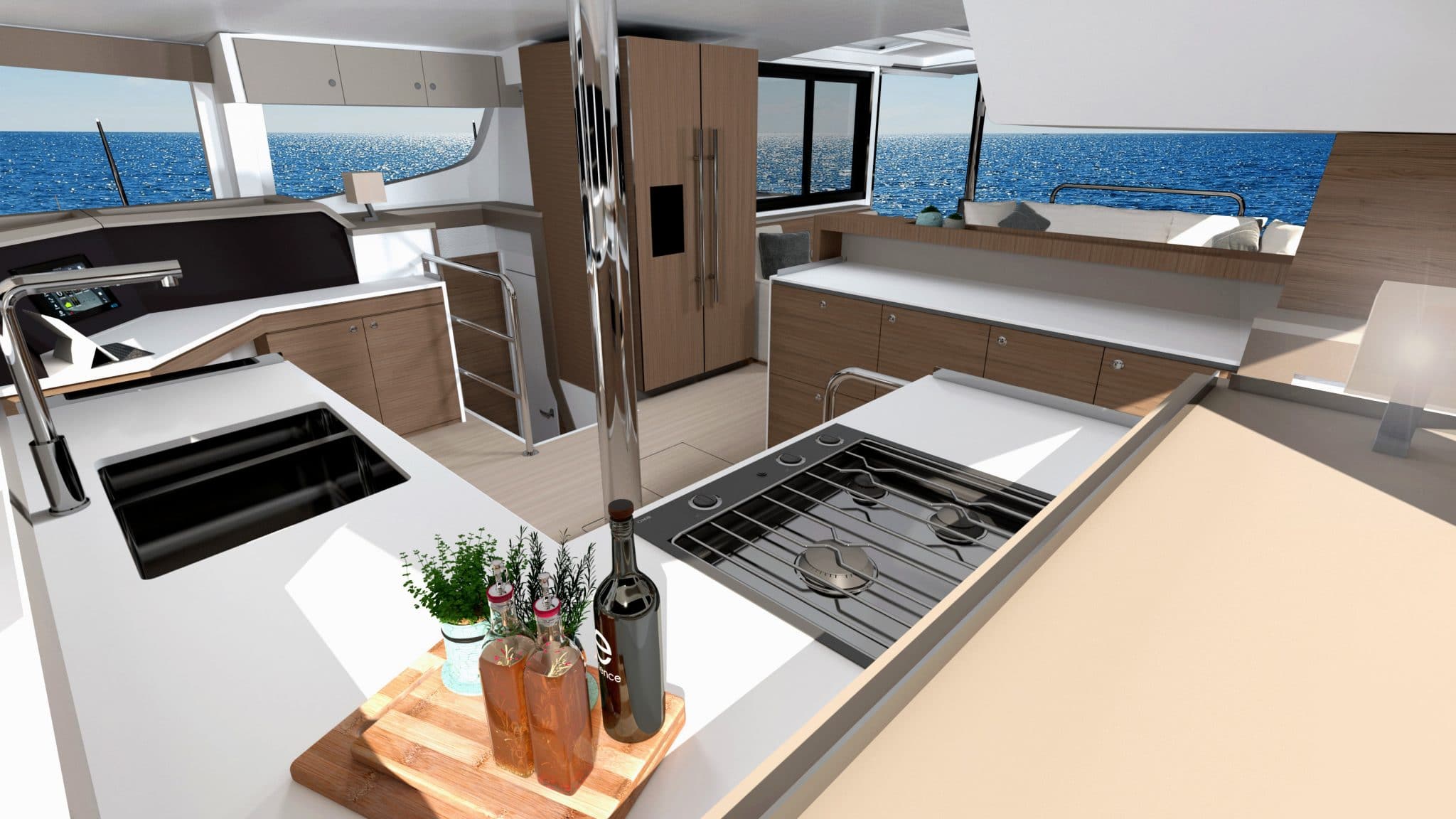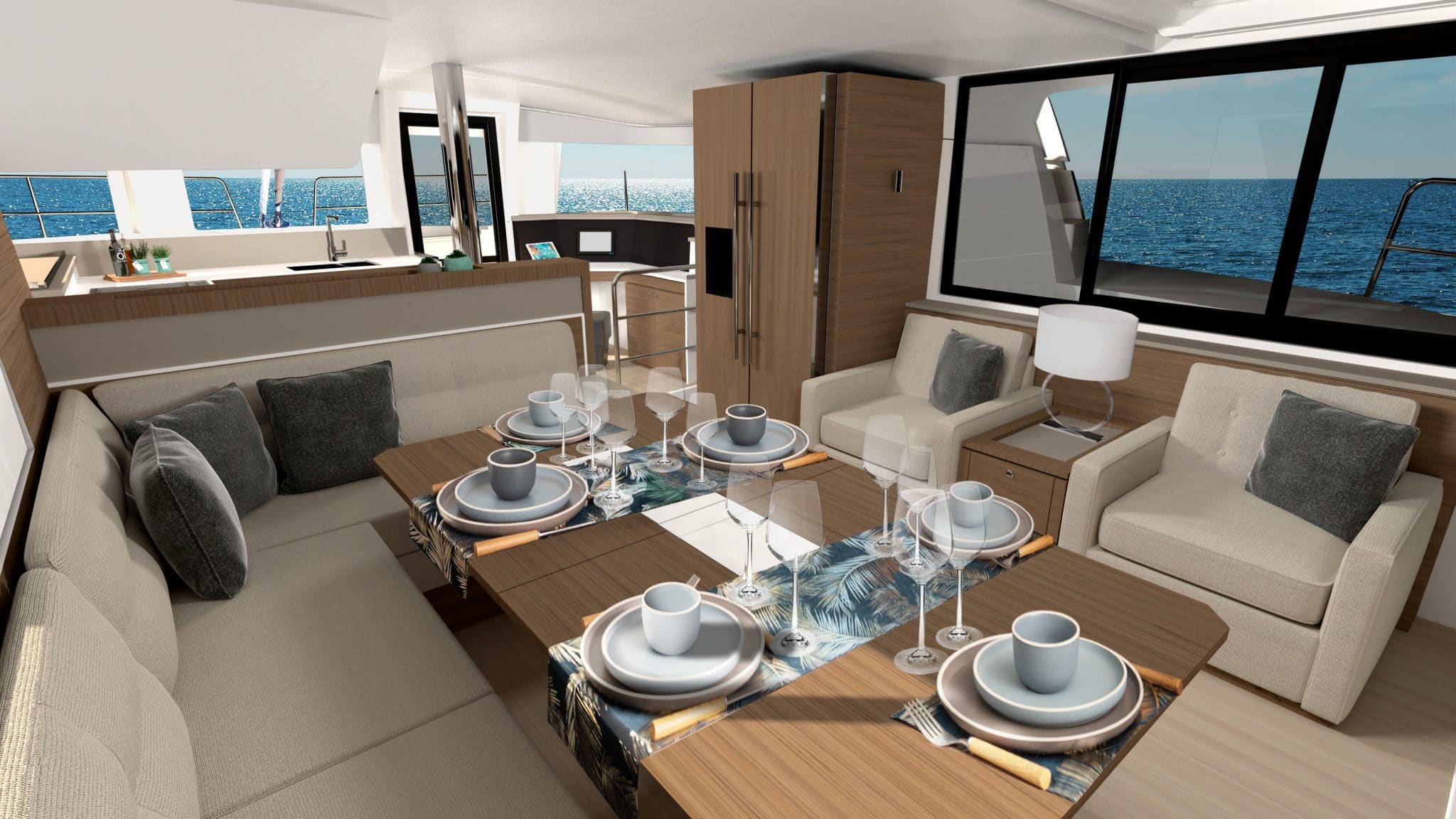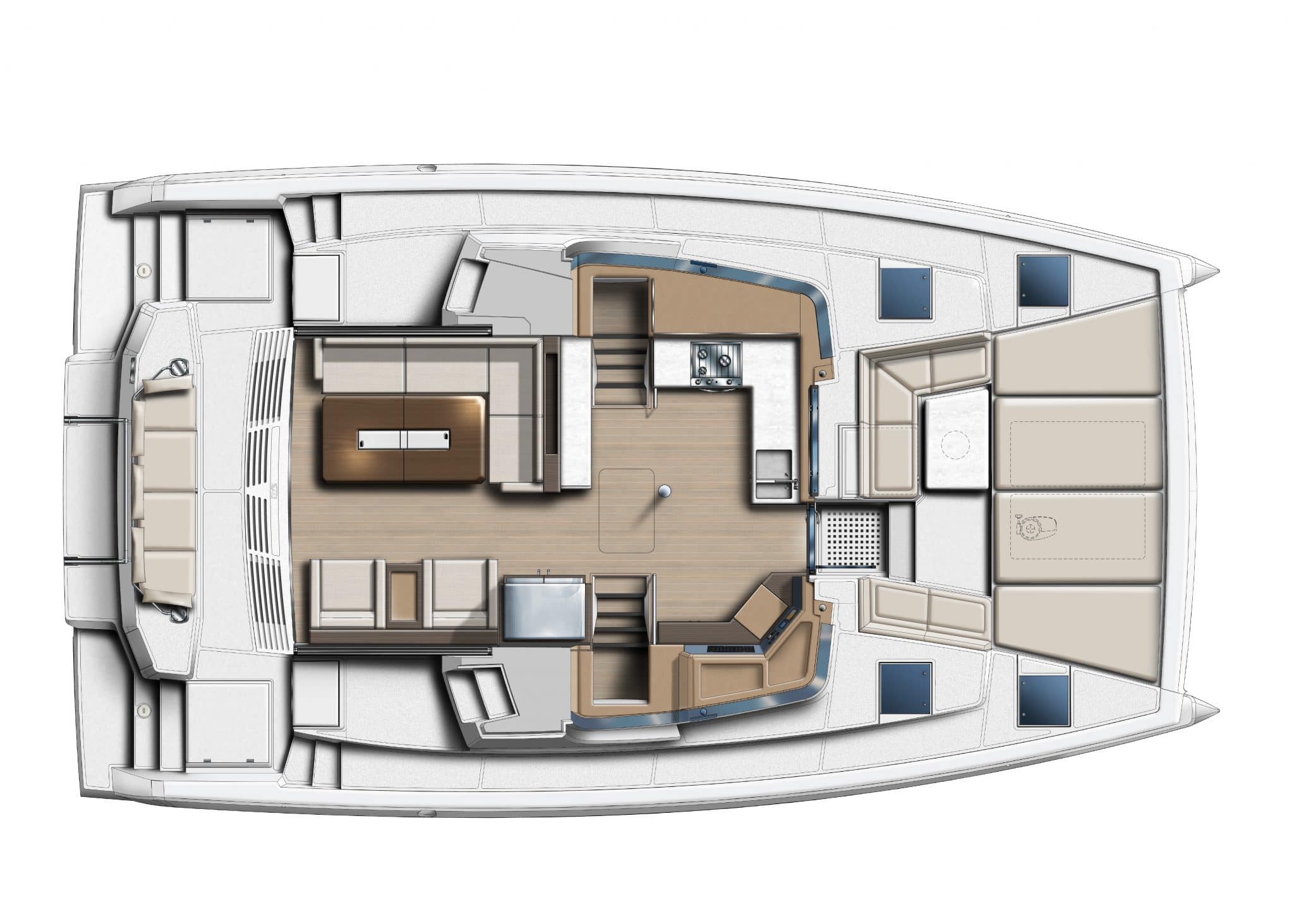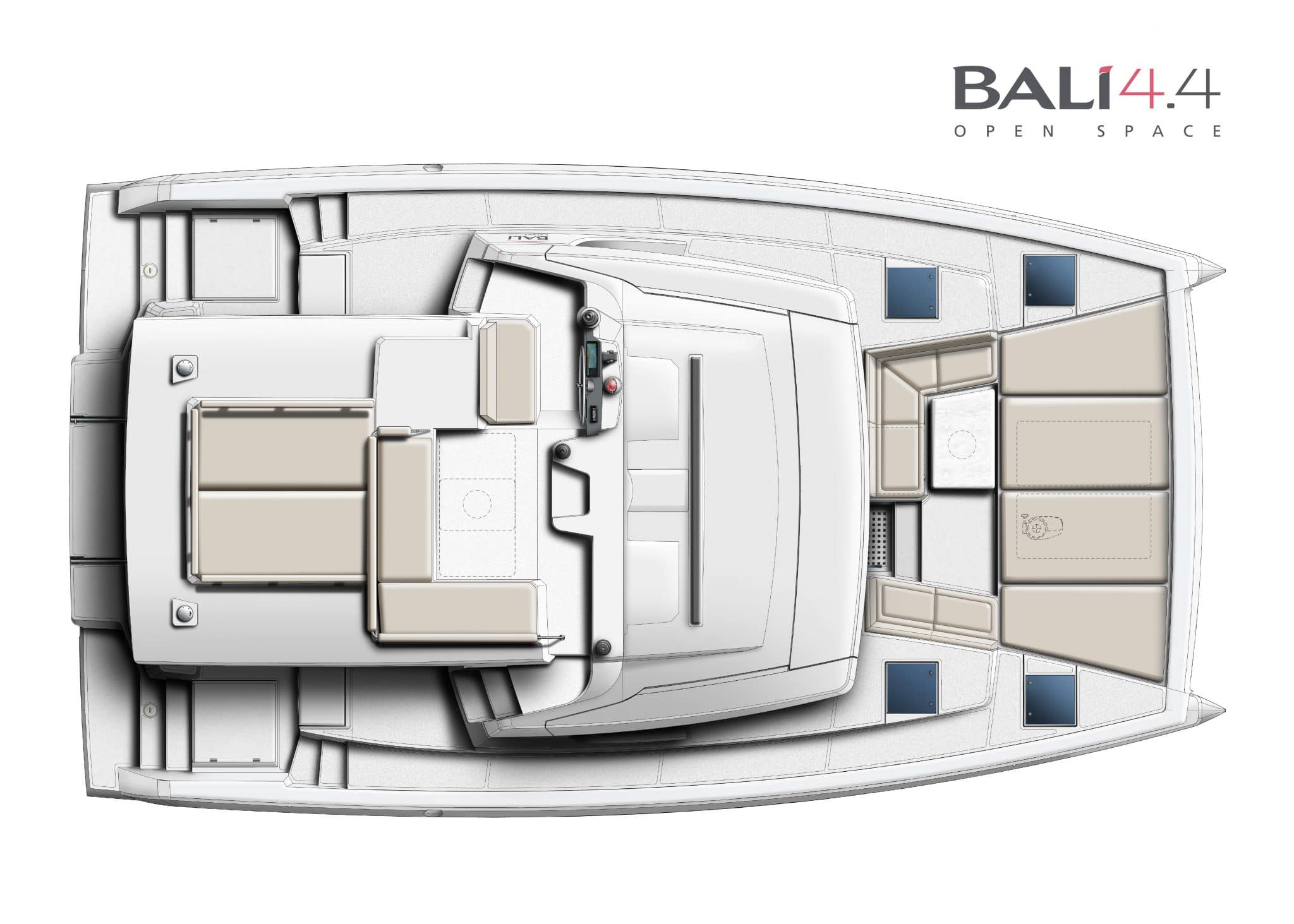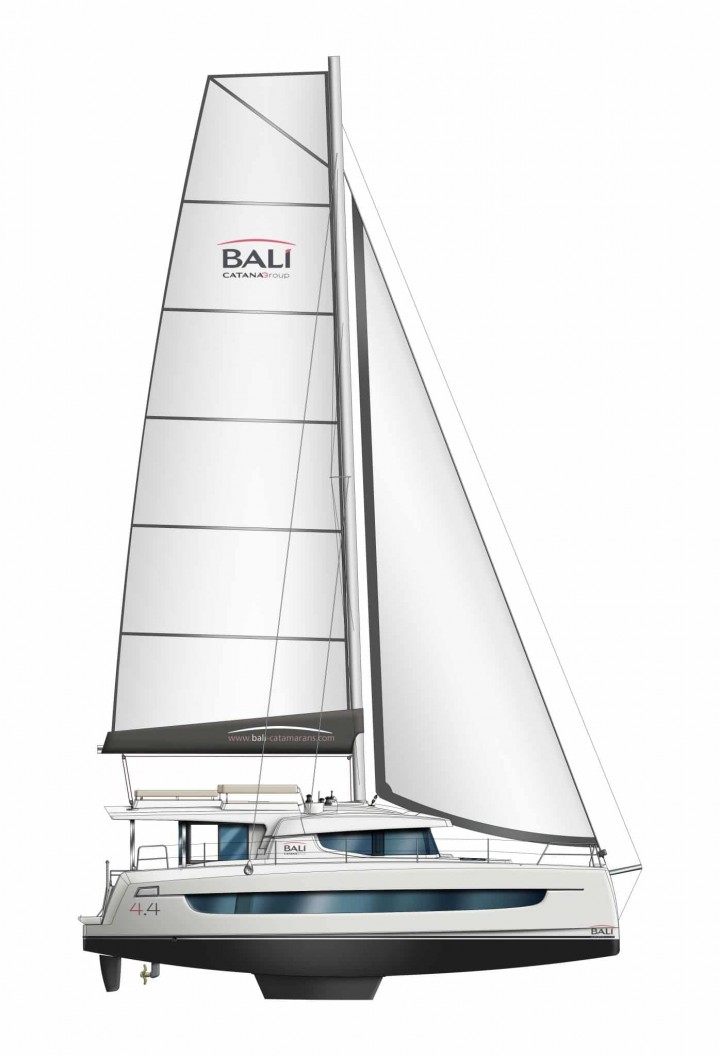Hedonism ensured
Step onboard the glorious Bali 4.4 catamaran.
Written by Emmanuel van Deth
12 July 2022
Advertisement
With the wind on the beam, the Bali 4.4 catamaran is making 8 knots and we’re inside, warm, dry and enjoying oysters.
The new 4.4 is in some ways a replacement for the Bali 4.3, but particularly the 4.5, the very first model in the Bali range. Aboard this model, more than ever dedicated to comfort and family vacations, all attributes of the Bali DNA can be found – tilting doors, opening side bay windows, a rigid foredeck and large fridge capacity.
As a bonus, with the size of this model being closer to the 4.6 than the 4.4, there’s a forward door, flybridge and aft platform.
We had the chance to try this new Bali as a preview, and very early in the season, too. That didn’t prevent us from enjoying the hedonistic spirit intended by the designers.
But it wasn’t all easy. Persistent fog, freezing temperatures and especially frosty ropes didn’t make for very inviting sailing.
Advertisement
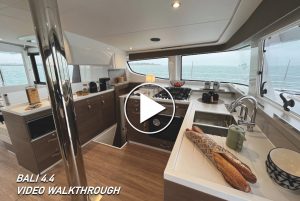
On the dock, Boris Compagnon, Sales Director of the Catana Group, and Kahina Oussadi, from their Communications Department came up with a few spare electric heaters and hooked them up to the mains, giving us a few more degrees of warmth inside.
Of course, all this meant that we weren’t going to be taking advantage of the Open Space mode, one of the big features on every Bali model. This time, we were keeping everything closed.
Yet, I have to admit that the Winter configuration is also very compelling. The XXL area of the nacelle and the large windows are very pleasing indeed.
Deck plan designed for relaxation yet remains functional
Volunteers were, however, required to step out onto the frosty deck to try and release our stiff-as-a-board mooring lines. Once clear of the dock, retrieving the fenders wasn’t so easy either; frozen clove hitches are a nuisance, too.
We managed to avoid getting wet, but it was a close call. We entered the Chenal des Minimes channel under engine, our particular model being fitted with the optional twin 57 HP Yanmar motors.
It was straight away apparent that the motors propel the boat with little effort, given we were up to about 7 knots at 2,150 rpm – aided only a little by the north-east wind, as we hardly noticed any difference when we turned and headed into it.
A quick visit to the aft cabins confirmed that any engine noise is well contained – nothing like the memories I have of the last Bali I tried, the Catspace. In fact, Olivier Poncin, the head of the Catana Group, confirmed that he asked his teams to deal with the soundproofing.
Despite the cold, the halyards and sheets managed to run over their respective sheaves, round the winches and through the clutches.
Though the deck layout has been designed specifically for relaxation with a maximum area of rigid deck space, thanks to the integrated foredeck and the mobile platform that perfectly extends the sugarscoops, it remains perfectly functional with fluid circulation everywhere.
Underfoot, the composite sandwich is very stiff, proof of careful and generously sampled construction.
Up on the flybridge, accessible from both sides, manoeuvring is simple: everything happens from the helm station, which is offset to port. At 4 feet (1.23-metres) wide, the seat is comfortable.
The view forward is good, somewhat less-so looking astern. The rest of the flybridge is fully equipped, but the designers wanted to limit the height of the boom. In fact, the lazy bag is easily accessible and the mainsail area is larger.
Up front, the hard deck is entirely covered with sun beds. This looks good, though perhaps not for the day of our test, but opening the lockers is more complicated with all the mattresses.
The aft cockpit, if one can define it as such, is home to a large bench seat of 8’8” (2.63-metres), the sugarscoops and the hydraulic platform.
The indispensable Code 0
As soon as the mainsail was hoisted and the Code 0 unfurled, we trimmed the traveler and the sheets. With the wind oscillating between 8 and 15 knots on the beam, our boat speed was between 7 and 8 knots with a few peaks at 9 knots during small gusts.
When the main is set just right, with all its telltales flapping horizontally, you can clearly feel that the Bali 4.4 is just waiting to be sailed.
The helm, without being especially wonderful, is fairly soft and direct. A few details remain to be worked out regarding the Code 0 sheeting system, the lines are subject to various chafe spots along their course.
When gybing, the lazy sheet gets caught under the angle of the coachroof before it can be taken in again.
On this point, Boris advised me that usually, you would furl and unfurl. The Code 0, promoted by the yard, brings an obvious bonus up to about 70-degrees off the wind.
It won’t go higher as the sheeting angle logically passes outside the shrouds. To get closer to the wind, we rolled up the Code 0 and unfurled the self-tacking solent. This reduces the headsail area from 796-square-feet down to 452 (74 to 42-square-metres).
Despite a sail area to weight ratio of 8.68-square-metres to the tonne, which is more favourable than the 7.07 of the Bali 4.2, the difference in punch is clearly felt.
When we came up to 50/55-degrees off the true wind, boat speed barely exceeded 5 knots, leeway was noticeable, and the sail trim needed to be quite precise.
We’re clearly not looking at ideal conditions of a comfortable cruising catamaran for sailing 100 percent under sail. The engines (or one of the pair) are there to help you maintain your course.
Better than home
During most of our day of sailing, we stayed warm inside, the perfect view over the water allowing us to keep a close watch while the autopilot remote control did the rest.
Obviously, some changes in angle of the wind coming off the coast did force some crew up onto the flybridge to make adjustments.
For the rest, we were able to taste oysters – the famous Marennes d’Oléron, of course – while making good speed towards the island of Ile d’Aix. The level of comfort inside the nacelle is enhanced by its generous headroom, which varies between 5’6” and 7’3” (1.98 to 2.22-metres).
The Elegance finish on our test boat (a three-cabin Owner’s model), with its specific upholstery including armrests, two club chairs, and integrated bar and leather handles for the storage spaces, offers a neat Owner’s version touch.
The galley features a large L-shaped work surface complemented by a sideboard that almost turns into a U-shape, not to mention the XXL-sized refrigerator.
The recess for the helm stations is perfectly integrated into the whole. The table measures 64” by 39” (1.63 x 1-metre), though this is larger on the charter version. Forward, to starboard, a chart table (16”/40-centimetres wide) is fitted.
The port hull is entirely dedicated to the Owner and is accessed by heading down a five-step companionway (4’2”/128-centimetres).
Here, you’ll find a big double bunk (6’7” x 5’3”/2 x 1.60-metres) configured as an island bed, a dressing table/desk of 33” by 21” (83 x 53-centimetres), a huge bathroom, large windows in the hull, two opening portlights and numerous storage spaces. Really, there’s nothing missing!
The companionway to the starboard hull has a sturdy handrail, which will be very useful in choppy seas. The aft cabin has the same dimensions as on the port side, with a minimum headroom of 6’5” (1.97-metres).
There are two bathrooms in this hull, and up forward, the bed is a little narrower at 4’9” (1.46-metres) than at the stern, but it is also much higher.
It’s perched at 35” (90-centimetres) from the floor – as opposed to 22” (55-centimetres) in the aft cabin. Small steps have been provided, but they could be larger.
As for the rest, there’s nothing to complain about: a sea view thanks to the large hull windows, great ventilation, plenty of storage space. These cabins are successful.
Heading back to the harbour at the end of the day, the fog finally deigned to lift, giving way to bright sunlight. It was time to check out the Open Space feature.
The small door measuring 5’9” by 26” (1.76 x 0.67-metres) gives way to the large Bali door into which it’s integrated. This immense rear façade of the deckhouse measures 11½ feet (3.5-metres) wide by 6’3” (1.92-metres) high and is electrically operated in just under 25 seconds.
The entire platform is then open to the rear, while the door at the front leads directly to the foredeck. The circulation is thus very fluid, and the natural ventilation will be particularly effective – or at least it will in warm weather.
Conclusion
Lovers of sailing hard on the wind, of rewarding VMG and of sharp silhouettes will undoubtedly remain hungry with this Bali 4.4.
But that’s not really fair, because this new catamaran is not really aimed at them (although that might be up for debate after trying it out for a few days) but rather to boaters who want a platform for enjoying life on the water – a home that can be moved from anchorage to anchorage and even from one ocean to another.
A concept that may sound heathen to sailing purists, however, the figures look to be proving the epicureans right, for this 2021/2022 vintage, no less than 280 of these Bali catamarans will be coming out of the three Catana Group factories. Already, 400 units are planned for the following year.
Far from being reserved for tropical or summer use, the Bali concept has shown us that it can also be used in much less favourable climates.
It comes as no surprise to hear that the range is proving to be a big hit in Scandinavian countries.
Plusses:
- Exceptional comfort.
- Improved standard of finish.
- Convincing performance off the wind in over 10 knots of breeze.
Minuses:
- Not great at upwind work.
- Code 0 sheet leads to be reviewed.
- Forecabin bunks very high.
Take a complete walk-through of the Bali 4.4 here.
Syndication shares available at Yacht Share Mariner.
Advertisement
Advertisement
Advertisement


